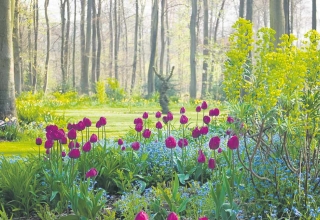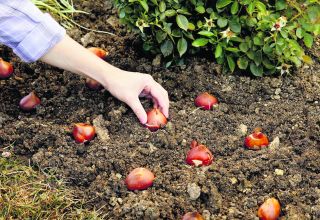
Autumn is officially here, in all its glory. It is also harvest time when the vegetable plot is thriving and fruit is plentiful so although there’s lots of work to do, there’s also the need to start planning for winter and yes even next spring. This may also be the first month some areas of the country experience their first frosts. Fruit and autumn veg are ready to be brought in and stored, and plants should be cut back, wrapped up or brought inside to help them survive the chilly winter temperatures.
Planting spring bulbs is the number one job
Late summer into early autumn is the best time to plant many varieties of spring bulbs (a notable exception being tulips, which should go into the ground between mid and late autumn) and a trip to the garden centre should reveal a tempting selection of bulbs displayed in pick-and-mix style boxes, including daffodil, crocus, camassia, hyacinth, fritillaria, anemone and iris.
However, if you are looking for rare or unusual flowers, you need to sort out a visit to a specialist nursery, but hurry. The best varieties often sell out quickly.
Before buying bulbs it’s worth checking to see that they’re healthy, otherwise a promising floral spectacle may turn into a damp squib. The best bulbs will feel firm and plump with no signs of damage or premature growth.
Discard any that are soft, shrivelled, battered, pitted or mouldy. It’s slightly more difficult to assess the quality of pre-packed bulbs, but don’t be afraid to have a good feel of the contents through the bag and put it back on the shelf if any feel squishy.
Bulbs are incredibly versatile and can be planted in the border, naturalised in grass or grown in pots – ideal if you have a tiny garden or even a balcony.
Either grow a single variety in a pot filled with bulb fibre, or if you’re feeling adventurous, try layering different types of bulb in the same container. For maximum impact choose flowers that appear at the same time (this will take practice).
If you’re naturalising in the lawn, don’t forget to put the cap of turf back on top. Some planters have markers on the side, which helps if you’ve got bulbs that need planting at a specific depth – generally, most varieties need a hole three times the size of the bulb.

Space-saving fruit
Many gardeners like the idea of growing fruit but find the business of rootstocks, pruning and pest and disease control too time consuming. Bush fruit (e.g. currants and gooseberries), offers a stress-free, rewarding entry to fruit growing. It’s also well suited to small town gardens.
Late autumn is an ideal time to plant. Choose a sunny, sheltered spot. Plants tolerate a range of soils, but ensure the site is well cultivated, weed-free and does not get waterlogged. In early spring, apply a general fertiliser or fish, blood and bone at 70g per square metre. A mulch of garden compost or manure in early spring is also beneficial.
Fruit is borne on a framework of main branches that is maintained from year to year, with the exception of blackcurrants, where up to a third of the oldest, unproductive stems are pruned out in winter on established bushes.
Get plants ready for Christmas
Prepared hyacinth bulbs can still be planted now. Use bulb fibre or general purpose compost but don’t be tempted to use ordinary soil which might contain worms. Bulbs should be close but not touching either each other or the sides of the pot. Fill with compost allowing the tips of the bulbs to show. Water, but don’t overwater, and place in a cool dark cellar, garage or somewhere similar. Check regularly, watering a little if necessary. You don’t want them to dry out. Once the shoots are a couple of inches high you can bring the pots indoors.

Keep deadheading dahlias
Frosts will eventually bring an end to their glories but until then do keep deadheading dahlias to give the plant the maximum chance to keep some flowers as long as possible. A quick way to tell flower bud from spent head: the spent heads are pointed in shape, the buds round.

Taking cuttings
Soft cuttings can be taken now of perennial wallflowers and salvias. Take cuttings of non flowering shoots, cutting above a bud. Remove all but the top leaves and place in a clean plastic bag until ready to trim and plant into fresh compost mixed with perlite. Cover with a plastic bag and stand in good light but out of direct sun.
Give a little time to the wild flowers
Wild flowers only need to be cut down once a year. Wait until they have finished flowering and the seed heads have ripened, adjust the lawnmower wheels onto their highest setting, remove the grass collection box and run the mover over them, or if you fancy a lot of exercise, try a scythe. Leave the cuttings on the ground for a few days to allow any seed heads to dry and for the seeds to fall. Collect up the remaining stems and put them in the compost heap.

Keep turning the compost heap
Turning the compost heap is really important at this time of year. As the garden is tidied in preparation for winter, lots of material is generated for composting so don’t just load the new material on top of what has been decomposing during the summer. To encourage the whole bed to rot down quickly, turn the contents regularly to stir it up and allow in lots of air. In the colder weather, the rate of decomposition will naturally decrease, but it will soon speed up during warmer spells.











